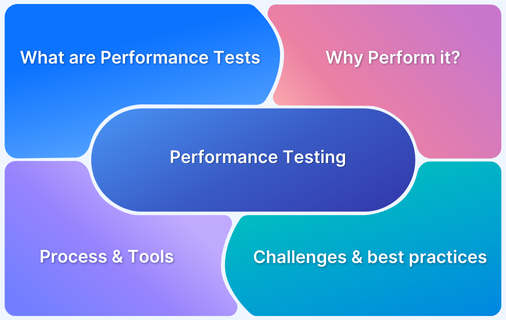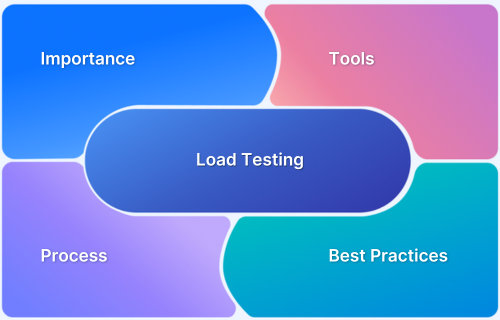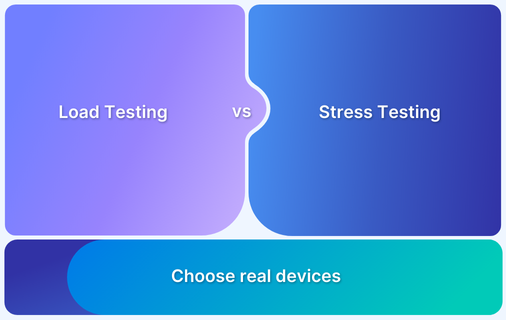Developers rely on specialized testing methods, such as performance testing, load testing, and stress testing, to ensure consistent performance across different conditions.
While often used interchangeably, each serves a distinct purpose in evaluating how an application performs under varying levels of demand.
This article breaks down the differences and overlaps between performance testing, load testing, and stress testing, explains when and why to use each, and highlights best practices.
Key Comparison: Load Testing vs Stress Testing vs Performance Testing
Here is a key comparison between Load Testing vs Stress Testing vs Performance Testing.
| Aspect | Load Testing | Stress Testing | Performance Testing |
|---|---|---|---|
| Purpose | To check how the system handles expected user load | To test how the system behaves under extreme or unexpected load | To evaluate how the system performs overall |
| Focus Area | Response time, throughput, and system behavior under load | Failure handling, system limits, and recovery after breakdown | Speed, stability, responsiveness, and resource usage |
| Test Scenarios | Simulates normal or expected user traffic | Simulates load beyond system limits | Includes various conditions like load, stress, and endurance |
| Duration | Short to medium duration | Short duration with sudden or extreme pressure | Depends on the test type |
| Expected Outcome | Confirms the system can manage the expected usage | Reveals system limits and recovery capability | Provides a full picture of system behavior |
What is Performance Testing?
Performance Testing is a type of software testing that checks how well an application performs under different conditions.
It’s not about whether the app works correctly (that’s functional testing), it’s about how fast, stable, and reliable the app is when real users use it.
Performance testing helps teams find and fix problems before users notice them and ensures that the application can handle real-world usage smoothly, especially during high-traffic times like big sales, product launches, or new feature rollouts.
Read More: Performance Testing Using Selenium
Performance testing focuses on areas such as:
- Reliability: Does the system return errors when the number of users increases?
- Stability: Is memory and CPU usage consistent and under control?
- Response Time: How quickly does the app respond to user actions?
- Scalability: Can the app handle more users or requests as demand grows?
Importance of Performance Testing
Performance testing is important for the following reasons:
- Improves user experience: Applications that load quickly and respond smoothly keep users engaged and satisfied.
- Prevents crashes and failures: It helps identify problems like slow responses, memory leaks, and system crashes before the application goes live.
- Protects business reputation and revenue: Poor performance during peak times can lead to customer frustration, loss of trust, and missed business opportunities.
- Ensures scalability: Performance testing shows whether the system can handle increased traffic or workload as the user base grows.
- Supports development improvements: The test results help developers optimize slow features, improve response time, and fine-tune system resources.
- Builds confidence in system stability: Teams can release updates and new features knowing the system can handle real-world usage.
Also Read: Guide to UI Performance Testing
Different Types of Performance Testing
Performance testing includes different types of testing, each designed to check how the system behaves in different situations.
Below are the main types performance testing:
- Load Testing: Load testing checks if the system can handle the expected number of users simultaneously. It simulates normal real-world usage to find out if everything works smoothly when many people use the app simultaneously.
- Stress Testing: Stress testing pushes the system beyond its normal limits to see how it behaves when overloaded. The goal is to find the breaking point – when the app starts to slow down, crash, or behave incorrectly – and see how it recovers.
- Spike Testing: Spike testing checks how the system performs when the number of users suddenly increases quickly. This helps determine whether the system can stay stable during traffic spikes, like during a flash sale or a viral post.
- Endurance Testing (Soak Testing): Endurance testing runs the system under a steady load for a long time. It helps identify issues like slow performance, memory leak, or other problems that may show up only after hours of usage.
- Volume Testing: Volume testing checks how well the system can handle large amounts of data. It tests how the database or file system performs when filled with many records or files.
- Scalability Testing: Scalability testing checks whether the system can grow to handle more users, data, or traffic over time. It helps ensure the app can scale up smoothly as the business grows.
- Configuration Testing: Configuration testing looks at how different system setups affect performance. It tests the app on different hardware, server settings, or software environments to find the best setup for speed and stability.
Read More: What is Non-Functional Testing?
What is Stress Testing?
Stress Testing is a type of performance testing that checks how a system behaves when it is pushed beyond its normal limits.
Stress testing helps identify the system’s breaking point and observes how well it recovers after failure. The goal is to simulate extreme conditions, such as too many users or too much data, to see whether the system can stay stable or crash, slow down, or produce errors.
Importance of Stress Testing
Stress testing is important because:
- Identifies system limits: It helps determine the maximum load the system can handle before it slows down or stops working.
- Checks recovery ability: It shows how well the system can recover after crashing or facing high pressure.
- Finds hidden problems: It detects issues like memory leaks, data errors or performance drops that may not appear during normal use.
- Prepares for real-world challenges: It ensures the system remains stable during unexpected traffic spikes or high usage periods.
- Improves reliability: It makes the system stronger and more stable for long-term use.
When to Perform Stress Testing
Stress testing should be done during key stages of development and before situations where the system may face heavy or unexpected loads.
Here are the common scenarios to perform stress testing:
- Before major product launches or marketing events, when a high number of users is expected.
- After significant updates or changes to the system’s code, architecture, or infrastructure.
- During planning for high-traffic periods, such as seasonal sales, ticket releases, or public announcements.
- When preparing for disaster recovery, it is important to check how the system responds during failures or overloads.
- This is for applications that handle critical operations, such as financial services, healthcare systems, or government platforms.
What is Load Testing?
Load Testing is a type of performance testing that checks how a system performs under expected user load.
Load Testing simulates real-world usage by applying a specific number of virtual users, transactions, or data requests to see if the system can handle them properly.
The main goal is to measure how the system behaves under normal usage conditions – how fast it responds, how stable it remains, and whether any parts slow down or fail as the load increases.
Importance of Load Testing
Key reasons why load testing is important include:
- Checks system capacity: It verifies how many users or requests the system can handle at once.
- Improves user experience: It helps maintain fast response times and smooth interactions during peak usage.
- Identifies bottlenecks: It finds parts of the system (like databases or APIs) that slow down under load.
- Prevents unexpected failures: It reduces the risk of crashes or slowdowns in production.
- Supports performance tuning: It helps developers fine-tune code and configurations for better efficiency.
When to Perform Load Testing
Load testing should be done whenever the system’s performance under regular traffic needs to be verified. It is beneficial during the following situations:
- Before releasing a new product or feature, ensure it performs well for users.
- After major code changes or updates that may affect performance.
- During scaling or infrastructure changes, such as moving to a new server or cloud setup.
- Before business events or campaigns that may attract higher traffic.
- As part of regular performance checks, to maintain long-term reliability.
Tools for Performance, Load, and Stress Testing
The right tools are crucial for effective performance, load, and stress testing. These tools help simulate real-world conditions and provide valuable insights into how systems perform under stress. Here are some of the top tools:
- BrowserStack App Performance: A comprehensive tool for evaluating mobile app performance, BrowserStack tests apps across 3,500+ real devices and simulates various network conditions, such as 3G, 4G, and Wi-Fi, to analyze responsiveness, speed, and stability under different conditions.
Features include real-time performance tracking, user flow analysis, and performance comparison, ensuring optimal app performance across devices. - Apache JMeter: An open-source tool used for simulating heavy loads and analyzing server performance. It is ideal for complex applications with static and dynamic resources.
- BlazeMeter: A cloud-based platform that supports Apache JMeter scripts, enabling scalable and continuous load testing with real-time traffic simulations.
- Locust: A scalable, open-source tool that lets you define user behavior using Python code, making it versatile for load testing web applications.
- Neoload: A cloud-based tool that handles extreme load scenarios and supports web and mobile apps, making it suitable for agile and DevOps teams.
- LoadView: A cloud-based stress testing tool using real browsers and simulating traffic from multiple locations to provide accurate user experience insights under stress.
- K6: A developer-focused, open-source tool for performance and load testing that integrates seamlessly into CI pipelines for continuous testing.
- LoadRunner: A comprehensive tool for simulating thousands of concurrent users, analyzing system performance, and identifying bottlenecks for optimization.
- Gatling: A real-time monitoring tool designed for continuous integration, ensuring high maintainability and efficiency in web application testing.
- New Relic: Provides real-time performance insights across your application stack, aiding in performance tuning and optimization during testing and production.
Read More: Top 20 Performance Testing Tools
How to Perform Performance Testing
Performance testing can be carried out using the following steps:
- Set Test Metrics: Start by deciding which performance indicators to measure. This could include response time, error rate, or system throughput. These metrics should align with business goals and product expectations. In ongoing testing setups, these metrics can help enforce Service Level Agreements (SLAs).
- Select Scenarios to Test: Identify user actions or workflows to test. For example, on an e-commerce platform, a useful test scenario might be the checkout process or browsing multiple product pages.
- Choose a Testing Tool: Select a tool that fits the project’s needs. Popular open-source tools include JMeter, Taurus, and Gatling. Platforms like BrowserStack can be used for advanced options such as test data, geolocation simulation, and detailed reporting.
- Configure Test Scripts: Set up the test by scripting the scenarios in the testing tool. Define the number of virtual users, test frequency, ramp-up time, and other conditions. Many tools allow test scenarios to be recorded and then edited. Add any necessary test data into the script to make the test more realistic.
- Run the Test: Once configured, run the test to simulate the selected user scenarios under load. The tool usually handles this step, which is usually straightforward.
- Monitor Results: After running the test, review the results to spot performance bottlenecks or slow components. Use the testing tool’s built-in dashboards for deeper insights.
- Optimize and Retest: Based on the results, fix any issues found during the test. After making improvements, retest the system to confirm that it meets the expected performance levels.
Similarities in Load Testing, Stress Testing, and Performance Testing
Here are the key similarities between Load testing, stress testing, and performance testing:
| Aspect | Similarities between load testing, stress testing, and performance testing |
|---|---|
| Testing Category | All are part of non-functional performance testing |
| Purpose | Evaluate how the system performs under various conditions |
| Tool Usage | Can be performed using similar tools (e.g., JMeter, LoadRunner, BrowserStack) |
| Focus on System Behavior | All of them test how the system responds to different levels of user activity |
| Helps Improve Reliability | Aims to make the system more stable, responsive, and ready for real-world use |
| Used Before Deployment | Commonly performed before major releases or system updates |
| Supports Optimization | Helps identify areas that need performance tuning or improvement |
Follow-Up Read: What to consider during Web Performance Testing?
Differences in Load Testing vs Stress Testing vs Performance Testing
The main differences between load, stress, and performance testing are explained below.
- Objective: Load testing checks how the system performs under expected traffic, stress testing evaluates performance under extreme conditions to find breakpoints, and performance testing assesses the system’s overall efficiency and stability across various scenarios.
- Load Conditions: Load testing uses normal traffic, stress testing applies excessive load to test system limits, and performance testing varies loads to measure scalability and efficiency.
- System Response Expectations: Load testing expects normal performance, stress testing anticipates failures and recovery, and performance testing expects optimal performance across different conditions.
- Focus Area: Load testing focuses on response time, throughput, and resource use; stress testing examines error handling and recovery; and performance testing evaluates speed, stability, scalability, and efficiency.
- Failure Expectation: Load testing expects no failures; stress testing seeks failure points; performance testing monitors failures to identify system weaknesses.
- Duration and Intensity: Load testing runs with steady, moderate load; stress testing involves short bursts of high intensity; performance testing duration and intensity depend on the test goal.
- When to Use: Load testing is used before release and scaling, stress testing is for high-traffic events or disaster recovery, and performance testing is used regularly during development to maintain quality.
Importance of Testing on Real Devices with BrowserStack
Testing on real devices is critical for capturing issues that simulators often miss, like network variability, device-specific bugs, and OS-level behavior.
It ensures your app performs reliably under real-world conditions, especially when load and performance are pushed to the limit. With BrowserStack Automate, using a real device cloud to replicate real user conditions can ensure accurate testing.
BrowserStack Automate enables comprehensive testing at scale with:
- Access to 3,500+ real devices and browsers for accurate performance metrics.
- Parallel test execution to speed up test cycles.
- CI/CD integration with Jenkins, GitHub Actions, and more for seamless automation.
- Built-in debugging tools like logs, screenshots, and video playback.
- Detailed performance insights to identify bottlenecks and optimize response times.
Best Practices for Performance Testing
Here are some key practices to follow for performance testing:
- Define Clear Performance Goals: Based on business needs, set clear targets for response time, load capacity, and acceptable error rates.
- Test Early and Regularly: Integrate performance testing early in the development cycle and repeat it often to catch issues before release.
- Use Realistic Workloads: Simulate real user behavior by designing test scenarios that reflect typical usage patterns and data.
- Monitor End-to-End Performance: Track the performance of every layer – application, database, network, and infrastructure – to find the root cause of issues.
- Test Under Different Conditions: Run tests under varying loads, network speeds, and configurations to see how the system responds in different environments.
- Include Performance Testing in CI/CD: Automate performance tests as part of the development pipeline to ensure consistent quality in every build.
- Review and Tune Regularly: Analyze test results, identify bottlenecks, and optimize code or infrastructure where needed.
- Maintain Historical Data: Keep records of test results over time to measure progress and detect performance regressions.
Conclusion
Performance, load, and stress testing are all important for ensuring an application works well under different conditions. Each type of test has its purpose – checking everyday usage, handling expected traffic, or seeing how the system reacts under pressure.
Using these tests together helps teams find problems early, improve system stability, and deliver a better user experience. Testing on real devices makes the results more accurate by showing how the application behaves in real-world situations.
Tools like BrowserStack make this process easier, allowing tests to run on thousands of real devices and browsers. With the right testing strategy and tools, teams can build faster, stronger, and more reliable applications.






